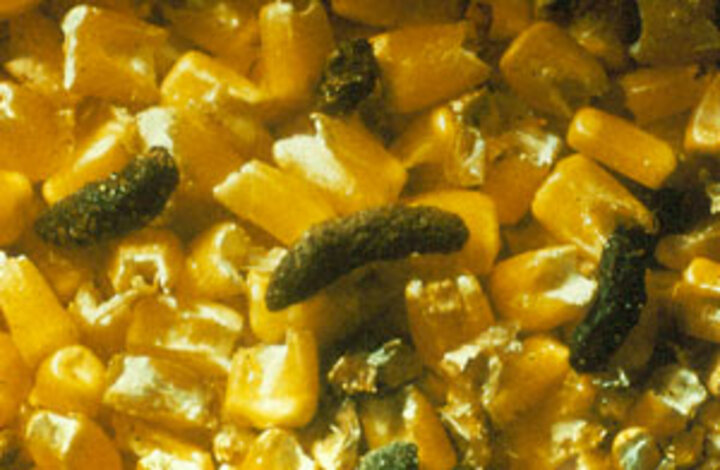June 14, 2012
Part I: Potential Impacts of Rodents on Stored Grain

Figure 1. Norway rat gnawing on a wooden structure. Rats can gnaw through almost any item softer than steel. (Photo by Robert Timm)

Rodent droppings can contaminate stored grain, Rodent Management
This is the first article in a three-part series. Also see: |
With last year’s crop in storage, you may think that a hard-summer’s work is over, but it isn’t. You need to protect your potential earnings from Norway rats (Rattus norvegicus) and house mice (Mus musculus). These rodents threaten stored grain by direct consumption, damage to the structures holding the grain, and contamination through defecation.
Grain Loss by Direct Consumption
Adult rats consume about 3 oz of food per day or about 50 lb of grain per year. While stored grain does not provide the complete nutritional balance they require, it can make up a significant portion of their dietary needs and sustain them until other foods become available. Mice consume 1/10 oz per day or about 2 lb of grain per year. Although grain consumption by rodents is estimated at just 1% of the total amount in storage, severe cases can result in substantial profit loss.
Grain Loss by Structural Damage
Rodents threaten grain by gnawing the structures and equipment used to protect it. They can gnaw through almost any item softer than steel. Wood, lead, soft aluminum, and electrical wires are frequent targets for rodents. Rats can then enter a storage bin through a space as small as 1/2 inch; mice need just a 1/4-inch hole. The resulting damage can increase heating costs, expose grain to moisture, disable electrical equipment, and cause fires. Researchers estimate that up to one-fourth of all fires in the U.S. are caused by rodents.
Grain Loss by Contamination
The feces and urine left by rodents poses the greatest threat to stored grain. Norway rats and house mice leave 20-50 droppings per day. These droppings will be strewn along the route taken by rodents traveling from den to feed sites each night. Urine, unlike droppings, is more difficult to spot. Rats excrete 1/2 oz of urine per night and mice leave hundreds of micro-droplets along trails. While the USDA tolerates one rodent dropping per 1000-gram sample of corn grain, why take the chance?
Conclusion
Rodents constitute a serious threat to the volume and quality of stored grain. Failure to appreciate the danger can result in significant financial losses. Fortunately, with the right management, the risks can be reduced substantially.
Resources
For more information on managing crop pests, see UNL Extension NebGuides available online at extension.unl.edu/publications.
Stephen Vantassel
Extension Wildlife Damage Coordinator
Scott Hygnstrom
Extension Vertebrate Pest Specialist
